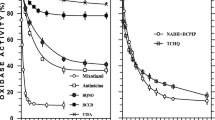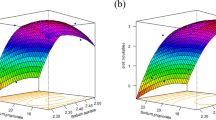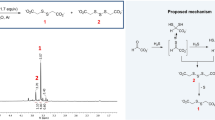Abstract
STUDIES with extracts from the anaerobic organism Clostridium kluyveri have shown that certain fatty acids are oxidized to acetate by processes similar in essentials to those in mammalian systems1 ; but the mechanisms employed by aerobic bacteria have remained obscure. Thus, although results with whole cells of Serratia marcescens2 did not apparently accord with β-oxidation, it has been shown more recently that extracts from Pseudomonas fluorescens3 catalyse the formation of acetate from decanoate with the uptake of one micromole of oxygen per micromole of substrate. In experiments with cell-free extracts prepared from a vibrio4, we have now been able to show that octanoic acid is oxidized by molecular oxygen to 2C units ; that diphosphopyridine nucleotide, coenzyme A and magnesium ions are co-factors in this process ; and that subsequent oxidation is by way of the tricarboxylic acid cycle.
This is a preview of subscription content, access via your institution
Access options
Subscribe to this journal
Receive 51 print issues and online access
$199.00 per year
only $3.90 per issue
Buy this article
- Purchase on Springer Link
- Instant access to full article PDF
Prices may be subject to local taxes which are calculated during checkout
Similar content being viewed by others
References
Stadtman, E. R., and Stadtman, T. C., “Ann. Rev. Microbiol.”, 7, 143 (1953).
Silliker, J. H., and Rittenberg, S. C., J. Bact., 61, 661 (1951); 64, 197 (1952).
Ivler, D., Wolfe, J. B., and Rittenberg, S. C., J. Bact., 70, 99 (1955).
Happold, F. C., and Key, A., J. Hyg., 32, 573 (1932).
Dagley, S., and Patel, M. D., Biochim. et Biophys. Acta, 16, 418 (1955).
Hughes, D. E., Brit. J. Exp. Path., 32, 97 (1951).
Dagley, S., and Walker, J. R. L., Biochem. J., 61, xv (1955).
Dagley, S., and Rodgers, A., J. Bact., 66, 620 (1953).
Lynen, F., and Ochoa, S., Biochim. et Biophys. Acta, 12, 299 (1953).
Author information
Authors and Affiliations
Rights and permissions
About this article
Cite this article
DAGLEY, S. Oxidation of Octanoic Acid by Cell-free Bacterial Extracts. Nature 177, 1131–1132 (1956). https://doi.org/10.1038/1771131a0
Issue Date:
DOI: https://doi.org/10.1038/1771131a0
Comments
By submitting a comment you agree to abide by our Terms and Community Guidelines. If you find something abusive or that does not comply with our terms or guidelines please flag it as inappropriate.



